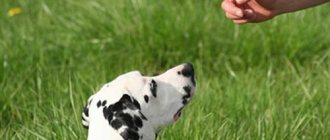When choosing a puppy, some owners are afraid of excessive aggressiveness, which can cause many problems. But sometimes a radically opposite problem arises. The dog not only does not show aggression, but is also terrified of strangers and experiences severe fear in unfamiliar areas. For the most part, these are the consequences of improper socialization, which takes place during the first three months. The puppy must be introduced to strangers and the space for movement must not be limited. But if your pet already has a fear of people or unfamiliar areas, these problems need to be dealt with.
Factors that shape fears in dogs
The main reason for fear of people on the streets is rough treatment of a pet at an early age. Fear can be expressed in different ways. The dog clings to the owner, tries to hide behind his legs, or rushes and barks at everyone he meets. This behavior is formed in puppies who, during the period of socialization, did not see strangers and communicated only with the owner.
The cause of fear may be a weakened nervous system. This is an innate character trait. As these pets grow older, they begin to develop various phobias. Eliminating such pathologies is extremely difficult; you will have to spend a lot of time and effort.
In some cases, it is impossible to determine the cause of fear or phobia. For example, a dog is afraid of one of the family members who has a loud voice or is tall. The dog is afraid of strangers with such qualities.
The dog often yawns when near its owner
Sometimes I see a dog yawning over and over again, which means he may be nervous. Some dogs may exhibit this behavior even if they are not tired. Just like people, dogs can experience nervous tics when they are around someone they are uncomfortable with. For example, a person plays with his hair or shakes his leg, or bites his nails when he is nervous.
Eggs with lemon will reduce hair loss. 10 effective homemade masks
A knitted cardigan has become a trend for winter 2021: how to wear it (learning from bloggers)
A fashionable designer house was “hidden” behind an unsightly wall: interior photos
The nature of fear of people
Most dogs experience panic fear of a specific person, a representative of a certain group of people. This feeling, for example, can be caused by representatives of a certain profession, dressed in a uniform, having a certain smell. This is a consequence of pain caused in the past, resentment from such a person.
Pets are often afraid of veterinarians, since a visit to a veterinary hospital was associated with discomfort and pain. If your dog has ever been hit by a bicycle, he may be afraid of this type of transport.
The dog doesn't make eye contact
If a dog moves away from its owner when he tries to pet it, it means that it is uncomfortable. Sometimes a dog may deliberately ignore its owner. I always notice whether the dog looks into the owner's eyes or whether he walks away every time he tries to approach her.
I cooked scrambled eggs incorrectly: it turns out that you don’t even need to cover them with a lid
Finally met! An English woman returned a stolen dog to its owner
Complete unity with nature: architects built a stone house on a hill
Passive behavior of a pet when fear appears
Fear can provoke a passive reaction. In this case, the dog, frightened of a stranger, tries to run away, hide, or hide in a secluded place. This is what phlegmatic, melancholic animals do. The owner needs to wait until the dog moves to a safe distance. If she is not going to stop and continues to walk in search of a secluded place, you need to command: “come to me,” calling her nickname.
When the pet stops, you should calmly approach him. If the dog’s feeling of fear has passed, he has calmed down, you can fix the leash and give the command “near”. You can play with the dog to distract it, order it to bring a stick, etc.
Pets who do not feel confident in their abilities behave passively. The owner should know that the best educational tool is personal example. In such a situation, you should not fuss, be nervous, or make sudden movements. You need to show the dog that everything is fine, there is no reason to worry. The pet will copy the owner's behavior.
Types of behavioral reactions when you are afraid of a person
Before correcting previous mistakes, you need to admit that they existed and clearly determine what action (or series of actions) led to the emergence of a phobia. Human fear is primarily mistrust. Typically, a pet’s concerns are expressed in two forms:
- Passive-defensive reaction - flattened ears and tail, frequent licking of the muzzle, darting eyes, an attempt to run away, hide or take a lying position, uncontrolled urination.
- An aggressive-defensive reaction is a consequence of a passive reaction to increased stimuli or an independent behavioral type. The dog grins, growls or barks. Turns away and tries to stick its muzzle into a corner or under furniture (then the dog will make a jerk towards the irritant and bite). The gaze is focused and controlling.
If, when showing a defensive reaction to the psyche, the dog continues to press, the next stage of defense begins. The animal whines, snaps its jaws in the air at the slightest attempt to approach, bites furniture or other objects nearby. There is trembling and severe salivation. Usually, at this stage, the body temperature of the quadruped increases greatly.
Important! The good news is that you can work with any type of defensive reaction and with the proper patience, your pet's behavior can be corrected.
Aggressive response to fear
Impulsive natures, choleric people, sanguine people do not run away when a feeling of fear appears. On the contrary, they immediately rush to an object that evokes negative emotions. If a dog not only barks at strangers, but also uses its teeth, it will not be possible to cope with such a pathology without a dog handler. Professionals know how to correct the behavior of such dogs.
If the pet barks, growls, but does not take active actions, you need to calmly and confidently approach him, take him by the collar and lightly pull him, give the command “quiet”. If this measure does not have the desired effect, you should squeeze the dog’s sternum with your knees and hold it until the object that caused the dog’s aggression leaves. Then you need to sit him down, sternly but calmly say “ok”.
You cannot pet or praise your pet when it is aggressive. If such inappropriate behavior appears, it is necessary to begin intensive socialization. Regular walks will be an important point. Gradually, you need to change walking areas from deserted ones to areas with active traffic, so that the dog gets used to it and understands that strangers do not pose a danger to it. A prerequisite is a friendly attitude towards the pet, calm, confident behavior in all situations.
Why is the dog afraid?
Why is this happening? Dog owners often believe that “the poor little dog was beaten” at the shelter. Actually this is not true. In municipal shelters, where the actions of the staff are monitored by volunteers, it is still not customary to beat dogs. Not a single volunteer will ignore this fact, and will ensure that the employee who allowed this to happen is fired. However, this does not mean that the dogs are in favorable conditions - barking and noise reign in the shelter. During cleaning, some dogs may experience stress because workers walk around with brooms, shovels, and make noise while cleaning the enclosure. This does not cause any inconvenience to some dogs; they get used to such noise and react normally to it. For a dog with a more subtle mental organization, such an environment is not suitable. But she is forced to stay in the shelter, which does not contribute to her peace of mind.
Of course, we don't know the dog's history before it arrived at the shelter. But according to my personal observations, the most fearful are those who grew up in a shelter from puppyhood. If a dog comes to a shelter as an adult, and even from the street, it suffers less from the surrounding reality, because it is used to many things.
The second common cause of fear in dogs is lack of socialization. The dog knows its volunteer, reacts normally to him, and walks well with him. But where can she get the experience of social communication with other people, with a different environment - an apartment, a house, a street, if she sees nothing except the shelter? Therefore, it turns out that the volunteer considers the dog to be sociable, but in reality it is poorly prepared for the outside world. And the saddest thing is that if such a dog does not find a family, then it can remain in this situation all its life. Only a new home, patience and care from the new owner can save such a dog.
Is it possible to determine whether a dog will be afraid?
If a dog walks calmly with a volunteer on a leash, but when it first meets you it shows caution, is in no hurry to run up to you or take a treat from your hands - but after some time it begins to show interest, comes up and sniffs you, this means that she's a bit shy
.
This shyness can go away quite quickly, within a few weeks
. You will have to show a little patience for the dog to become truly domestic.
If a dog shys away from you, tears the leash to the side, is not ready to walk from the shelter to the car, and has to be literally dragged, then this means that it is poorly socialized
.
And here you need to think hard about whether it is worth adopting
such a dog from a shelter.
Of course, if you take this dog, you will simply save
it.
But think about it, will you have the strength
to overcome your dog’s fear for many months and patiently accustom it to its surroundings? If you feel the strength and even the need to save a living being, you can go for this experiment. If not, abandon this idea.
There is a great way out of this situation - get a temporary pass and go to the shelter to see this dog at least once a week
- walk with her, talk, feed her, brush her, in general, make her your friend. Then the process of socializing the dog in your home, when you take it in, will go much faster!
Eliminating fears of unfamiliar terrain
Not every pet easily and quickly masters new territories. For some dogs, such changes can cause panic. There are recommendations from professional dog handlers that allow you to cope with this problem. One effective way is to regularly create situations that cause fear. You can eliminate the phobia gradually if you take the dog with you everywhere: on a trip, to the dacha, on a visit, to the forest, etc. Over time, the pet will understand that someone else’s environment is not dangerous, there is no reason to be afraid.
The owner needs to monitor the dog’s emotions in such situations. If he begins to develop a feeling of anxiety, you can lightly slap him on the back with your palm several times. This gesture will show the dog that he can calm down, everything is fine. When going for a walk, you need to grab a treat, your dog’s favorite toy. They will help distract the dog if it gets scared and starts to panic.
If you cannot cope with fears in these ways, you need to find the owner of a brave, self-confident dog and take walks together. The calmness and courage of a friend will definitely be transferred to the pet.
If you had to move to a new place, and the dog is terrified of a foreign area, you should try to smooth out the contrasts. To do this, you need to maintain the same routine of walking and feeding, at least at first. You can come to a convenient schedule gradually by shifting the time by a few minutes. This will help reduce the intensity of stress. During the adaptation period, more time should be allocated for caring for the dog and playing together.
Unfortunately, sometimes a dog has to change not only its place of residence, but also its beloved owner. You need to prepare for the fact that the dog may have a desire to run away in search of its previous owner. Therefore, it is impossible to leave him alone on the street during this period. The pet may have a feeling of hostility towards the new owner, even with careful care. You should not be offended, you need to be patient, try to please the dog, create maximum comfort, and give food often. You can feed the dog by hand to establish contact. During the first weeks, you need to spend as much time as possible with your pet and be close.
The dog is afraid of people - how you can help
Category: Education
The dog is afraid of people . Sometimes it happens. What is noteworthy is that a dog’s fear does not depend on its configuration or breed. Fear of people is either a character tendency or some actions up to three months of the puppy’s life that caused this fear. In this article we will look at why dogs are afraid of people and what you can do about it.
As I already wrote above, the first three months of life for a puppy are one of the most important stages of socialization. At this time, the puppy should be introduced to as many people and animals as possible. Do not impose, but simply show the puppy that the world is big and diverse.
Another option for the appearance of fear is a weak nervous system of the dog. When choosing a puppy, you need to find out from the breeder or take a closer look at the behavior of the puppy that appeals to you. The puppy must be brave. Not all breeders can now honestly and conscientiously weed out unbalanced characters in breeding dogs. And this is an important characteristic of a dog. By the way, this is also taken into account at exhibitions. Life is very difficult for a dog with such a cowardly character and you definitely need to help her so that she stops being afraid.
The dog is afraid of people and reacts to them in two ways: it hides in a corner or shows aggression. If your dog hides in a corner at the sight of a stranger, do not force him to leave. Persuasion, affection and treats will help here. Dog aggression is more difficult to suppress. In this case, there should be no possibility of a threat to the other person. Therefore, a muzzle is required. And then you need to go for a consultation with a trainer, because each case of aggression needs to be considered separately.
How to deal with a dog's fear? Psychologists who are involved in correcting the behavior of dogs advise in this case to show the dog that the source of fear is not dangerous. You need to walk your dog more often in crowded places. But you need to not just walk with her, but train, i.e. force to follow commands so that the dog switches from a feeling of fear to readiness to carry out commands. Such training should begin with a short period of time, gradually increasing the time interval. Come to a crowded place and give commands: sit, lie down, come to me, etc. During training, only your calm and firm voice, in addition to treats, will teach the dog that nothing terrible is happening and you don’t have to be afraid of people. Do not get angry or nervous under any circumstances. In this case, only positive motivation is important.
Another option that can be combined with the first. If you understand that your dog is now afraid (for example, a friend of yours is heading towards you), then give him the command “sit” and grab the leash tighter. The dog must develop a reflex to the appearance of fear. When feeling the fear of the unknown, the dog will sit next to the owner and wait for a further command or treat. When training a dog to be afraid of people, you will need a lot of goodies. Watch carefully so that your dog does not become a beggar.
Experienced dog breeders authoritatively state that when a dog is afraid of people , it can cope with its fear with the help of its owner. Never punish your dog for being afraid. You will need patience and kindness.
Is your dog afraid of people ?
Post Views: 29
Liked this:
Like Tags: raising a dog, dogs











